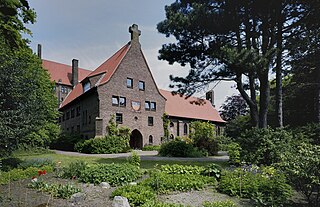
Wurmsbach Abbey is a monastery of Cistercian nuns located in Bollingen, a locality of Rapperswil-Jona, in the Canton of St. Gallen, Switzerland. It is located on the north shore of upper Lake Zürich. The house is a part of the Order of Cistercians of the Common Observance (O.Cist.).

Rottum is a small village on an artificial dwelling hill between Kantens and Usquert in the municipality of Het Hogeland, falling under the province Groningen in the Netherlands. It had a population of around 85 in January 2017.

Saint Juliana's Abbey was a Benedictine abbey dedicated to Juliana of Nicomedia in Rottum in the present-day Netherlands..

Burtscheid Abbey was a Benedictine monastery, after 1220 a Cistercian nunnery, located at Burtscheid, near Aachen, North Rhine-Westphalia, in Germany.

Göttweig Abbey is a Benedictine monastery near Krems in Lower Austria. It was founded in 1083 by Altmann, Bishop of Passau.

St. Gabriel's Abbey, is a Benedictine monastery in Styria. The nunnery was founded in 1889 in Prague and was raised to the rank of an abbey in 1893. St. Gabriel's was the first women's community to join the Beuronese Congregation within the Benedictine Confederation. After World War I, the predominantly German-speaking community relocated to the castle at Bertholdstein in Styria.

St. George's Abbey in the Black Forest was a Benedictine monastery in St. Georgen im Schwarzwald in the southern Black Forest in Baden-Württemberg, Germany.

Baindt Abbey, otherwise the Imperial Abbey of Baindt, was a Cistercian nunnery in Baindt in the district of Ravensburg in Baden-Württemberg, Germany.

St. Marx Abbey or St. Mark's Abbey was a Benedictine nunnery in Gueberschwihr (Geberschweier) in Alsace, founded in about 1105. Since 1845 it has been the principal house of the Sisters of St. Joseph of St. Marc, rebuilt in 1852 after a disastrous fire.

Rot an der Rot Abbey was a Premonstratensian monastery in Rot an der Rot in Upper Swabia, Baden-Württemberg, Germany. It was the first Premonstratensian monastery in the whole of Swabia. The imposing structure of the former monastery is situated on a hill between the valleys of the rivers Rot and Haslach. The monastery church, dedicated to St Verena, and the convent buildings are an important part of the Upper Swabian Baroque Route. Apart from the actual monastic buildings, a number of other structures have been preserved among which are the gates and the economy building.

Ælfgifu of Shaftesbury, also known as Elgiva and canonised as Saint Ælfgifu, was Queen of the English from 939 until her death c. 944 as the first wife of King Edmund I. Ælfgifu and Edward were the parents of two future English kings, Eadwig and Edgar the Peaceful. Like her mother Wynflaed, Ælfgifu had a close and special if unknown connection with the royal nunnery of Shaftesbury (Dorset), founded by King Alfred, where she was buried and soon revered as a saint. According to a pre-Conquest tradition from Winchester, her feast day is 18 May.

Egmond Abbey or St. Adalbert's Abbey is a Benedictine monastery of the Congregation of the Annunciation between Egmond aan den Hoef and Bakkum in Egmond-Binnen in the municipality of Bergen in the Dutch province of North Holland. Founded in 920-925 and destroyed in the Reformation, it was re-founded in 1935 as the present Sint-Adelbertabdij, in the Diocese of Haarlem.

Heilig Hüsli is a bridge chapel in Rapperswil, Canton of St. Gallen, Switzerland.

Swine Priory was a priory in the village of Swine in the East Riding of Yorkshire, England. The site of the Cistercian nunnery is a Scheduled Monument.
Stixwould Priory was a priory in Lincolnshire, England, a Cistercian nunnery founded by Lucy, countess of Chester, in 1135. The Mappa Mundi describes it as Gilbertine, but modern authors regard it as Premonstratensian. Originally suppressed in 1536, Benedictine nuns from Stainfield were then moved in by the King. In 1537 the nunnery was refounded for Premonstratensian canonesses, before being finally suppressed in 1539.

Solberga Abbey, was a Cistercian nunnery in Sweden, in operation from 1246 until at least 1469. It was located outside Visby on Gotland until 1404, and then in Visby. It was the only nunnery on the island of Gotland.
HMS Tyler (K576) was a British Captain-class frigate of the Royal Navy in commission during World War II. Originally constructed as a United States Navy Buckley-class destroyer escort, she served in the Royal Navy from 1944 to 1945.

Bloemkamp Abbey is a former Cistercian abbey in the Netherlands, located in Hartwerd in the municipality of Wûnseradiel to the north-east of Bolsward, in the province of Friesland.

Dom Hans van der Laan was a Dutch Benedictine monk and architect.

Rijnsburg Abbey was a Benedictine nunnery in Rijnsburg, Netherlands, active between 1133 until 1574.


















